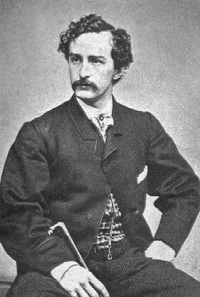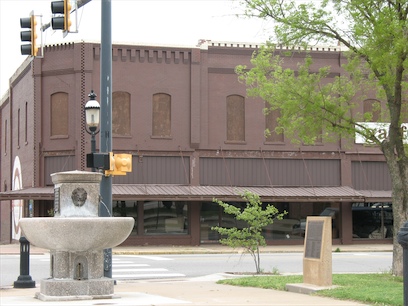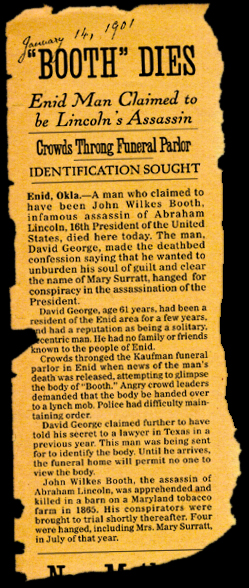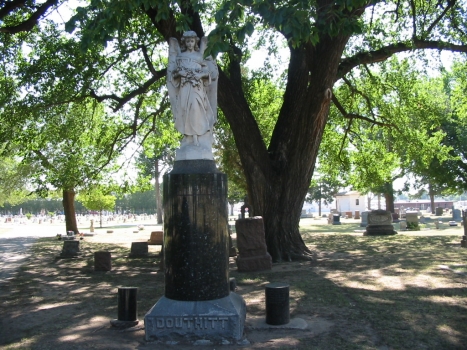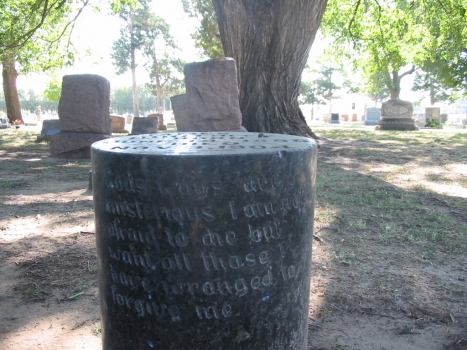We are currently redesigning this page. Stay tuned!!
The Legend of John Wilkes Booth
The legend says that John Wilkes Booth, the assassin of President Abraham Lincoln, died in Enid around 1903. A man named David E. George, committed suicide in Enid, Oklahoma Territory, in 1903 and is believed to have been Booth himself.
John Wilkes Booth was a noted actor and Confederate sympathizer and had originally planned on kidnapping Lincoln in exchange for Confederate prisoners. Due to a change in plans Booth decided to assassinate President Lincoln on April 14, 1865, at the Ford’s Theater in Washington. After shooting the President, Booth jumped to the stage, caught and broke his leg on a flag and fled the theater.History states that Booth escaped, but was found by federal soldiers several weeks later. He had hidden in a barn near Port Royal, Virginia, and would not surrender. The barn was eventually set on fire. Booth was supposedly shot and killed by Sgt. Boston Corbett of the Sixteenth New York Cavalry.Conflicting stories still exist about the identification of Booth’s body, and there were errors made in the identification process along with errors in supplying information to the public about the identification. Legend tells that Boston Corbett, the man who shot Booth against orders, was involved in identifying the body as Booth’s. This has fueled the speculation that Booth may not have been killed that night, but some other individual.
Enid, Oklahoma - Grand Avenue Hotel in 1903, upstairs behind boarded windows are rooms, one of which was where John Wilkes Booth possibly committed suicide.
Many years later on January 13, 1903, in the Booth Legend (upstairs in the current Garfield Furniture building) in Enid, Oklahoma, a man calling himself David E George was found dead. A doctor diagnosed his death as self-administered arsenic poisoning. George had been a house painter who did not know how to paint and always had access to money but died penniless. Legend has him quoted as saying”,,I killed the best man that ever lived.”
After George was embalmed, he was placed in a chair in the window of the furniture store/funeral home so that the public could view him, and a photograph was taken due to his “remarkable likeness” to Booth. George’s leg had also been broken above the right ankle-the same break that Booth had suffered in jumping from the Ford’s Theater balcony. However, the doctor who had set Booth’s leg had reported it to be the opposite leg.
About that time, a man named Finis L. Bates came to Enid to inspect the body. Bates identified George as an old friend and client of his named John St. Helen. Bates claimed to have known St. Helen (George) as a client and friend in the early 1870s. Bates stated that St. Helen had become seriously ill at one point and confessed that he was John Wilkes Booth. He supposedly gave information about the assassination and escape that only Booth would know.
Many facts that Bates published about St. Helen were proven to be inconsistent with documented facts. However, the body, which had been embalmed, was given to Bates, who began to lease the body to interested parties.
The body was even displayed at the St. Louis World’s Fair in 1904 and also at many sideshow carnivals. The body then went on a few more adventures and eventually disappeared.
The Postmortem Career of John Wilkes Booth, by R. J.Brown
The postmortem career of John Wilkes Booth, whether it belongs to true history or folklore, none-the-less provides a fascinating story. The mummy scattered ill-luck around almost as freely as Tutankhamen is alleged to have done…….
Story
Babcock’s evidence
This is a replica of the newspaper clipping Babcock showed to the Investigators, supporting his wild theories that John Wilkes Booth was not killed as the history books teach, but lived under false names for many years after the Civil War. There really was a guy who died in Enid Oklahoma in 1901 who claimed to have been John Wilkes Booth.
Local man describes visit to old Hotel room:
December 27, 2005
Did John Wilkes Booth die in Enid?
by Phil Brown
Commentary
This past week I followed a young woman up a flight of darkened stairs in one of Enid’s oldest downtown buildings. The stairs squeaked and occasionally popped under out feet. One hundred and three years ago, when it was the Grand Avenue Hotel, a house painter and local barfly committed suicide in one of the hotel’s upstairs rooms. His deathbed statement sparked a national controversy in 1903. The young woman was taking me to the room where he died a painful and violent death.
This past week I followed a young woman up a flight of darkened stairs in one of Enid’s oldest downtown buildings. The stairs squeaked and occasionally popped under out feet. One hundred and three years ago, when it was the Grand Avenue Hotel, a house painter and local barfly committed suicide in one of the hotel’s upstairs rooms. His deathbed statement sparked a national controversy in 1903. The young woman was taking me to the room where he died a painful and violent death.
The building is now, and has for several decades been, home to Enid’s Garfield Furniture Co.
At the end of the stairway she opened a door. We crossed a hallway. She stopped and opened a second door, revealing a long narrow room with a high ceiling. It looked more like a jail cell than a hotel room. There was one window facing Grand Avenue.
There was no bathroom, no running water — not even a wash basin.
On the left was a small wrought iron bed, its springs covered with a thin mattress-like pad covered in a faded-pink material. When I was a kid we called these daybeds.
At the foot of the bed there was a chair and a small round table. On the table sat a crusty looking kerosene lamp that looked as if it hadn’t been lighted in 100 years. I felt like I had walked into a tomb. The air was chilly and damp in this unheated portion of the old building.
There was no floor covering in the room, and what at some time in the building’s history may have been elegant red and gold wallpaper was severely faded now and peeling off the walls. Some of the plastering was missing from the ceiling revealing the wooden slats.
The room smelled old and it looked old. It was very depressing. It is the room where David E. George, a house painter from Texas who frequently quoted at length from Shakespeare’s plays in Enid bars, ingested strychnine, a powerful poison, on Jan.13, 1903, and died writhing in agony.
But before he breathed his last he told a physician who had been summoned to the hotel he really was John Wilkes Booth, the assassin who had killed President Abraham Lincoln 38 years earlier.
It wasn’t the first time George had “confessed.” He made a similar revelation years before in Texas when he thought he was dying. He lived in Texas under another name. In fact some say there were two earlier confessions when he had thought death was imminent.
There also is more than one story about what happened after the assassination. One story is Confederate sympathizers spirited him away, and he traveled incognito across the South, and down through Texas to Mexico.
He also supposedly told the story that after the assassination friends had taken him down the Potomac River to a place where he boarded a steamer for Europe. He said he had lived in Europe for 15 years before returning to the United States.
Well, John Wilkes Booth was a Shakespearean actor, and they say George could recite Shakespeare at will, reinforcing the story George was an actor. Booth broke a leg in his leap to the stage after shooting Lincoln. An examination revealed George also had broken a leg. He was Booth’s height and weight too, and resembled the actor.
And, of course, everyone remembered the doubt in the minds of the public following the chase and capture right after the assassination of the man presumed to be Booth, and the haste and secrecy of his burial.
Why would anyone on his deathbed confess to such a crime, not once, but several times, if it were not true? Why would he lie at a time like that? He had nothing to gain by lying.
George’s unclaimed remains were embalmed by the local Penniman’s Funeral Parlor, using arsenic, which did a marvelous job of preserving the remains. Penniman retained custody of the mummified remains for a number of years. He would tie the embalmed and fully dressed body to a rocking chair and display it in the store front window of the funeral parlor with a newspaper laying across its lap.
A Tennessee lawyer named Bates bought the body and kept it in his barn for 20 years while he tried to collect the reward offered by the government for Booth.
For a number of years George’s body was displayed at amusement parks and carnival sideshows in many states, before finally disappearing. There was a vague story going around several decades ago someone had seen the remains in a box in the basement of a building in some Midwestern city. But, when the man went back a few years later the building was gone. Only a parking lot remained.
If he really was John Wilkes Booth, his restless remains may still be seeking a peaceful repose.
Brown is a retired News & Eagle editor.
Did you know Enid was featured in a 2009 episode of Ghost Lab? They came to search Garfield Furniture for the ghost of John Wilkes Booth! You can see the store at 00:50 of this clip:
Knights of the Golden Circle
by Bret Burquest who is a former award-winning columnist and author of four novels. He lives in the Ozark Mountains with a dog named Buddy Lee and a multitude of wilderness paths.
See Link
Posted Wednesday, March 18, 2009, at 3:10 PM
reprinted in: The News, Salem Arkansas
Bob Brewer was born and raised in western Arkansas. As a youngster, his great-uncle introduced him to a mystery that included wilderness paths, hidden symbols, carvings on trees and rocks, and the topography of certain areas. The old man was the keeper of some sort of secret knowledge that he kept to himself.
Brewer went off to a career in the Navy and retired in 1977. He returned to Arkansas and began to explore the mystery of his childhood. Over the next 25 years, he interviewed old-timers, researched documents, studied old maps, made alliances and went on expeditions. He became convinced he was on the trail of lost treasure.
Warren Getler, a former Wall Street Journal investigative reporter, has teamed with Brewer to create the book titled SHADOW OF THE SENTINEL which reveals the mystery of the Knights of the Golden Circle and their involvement in a vast Civil War era conspiracy.
The Knights of the Golden Circle (KGC) was a secret society formed in 1854 by sympathizers of Southern causes, dedicated to supporting pro-slavery policies and promoting the conquest of Mexico. It was created directly out of the Scottish Rite of Freemasonry and linked to the highest circles of American Freemasons.
During the Civil War, KGC operatives amassed huge quantities of gold and silver through clandestine raids. The caches were hidden in various secret locations, particularly in Arkansas, Missouri, Oklahoma and Texas, marked by a trail of complicated KGC ciphers. The accumulation of riches continued after the end of the Civil War in anticipation of a second war. Operations ceased in 1922 and the caches were sealed for good.
Getler and Brewer claim that the infamous outlaw Jesse James, a member of the KGC who turned over much of his ill-gotten gain to the cause, wasn’t actually killed in 1882 by Bob Ford as reported. A fellow named Charlie Bigelow who resembled Jesse James had been robbing banks using Jesse’s name. Supposedly, Jesse killed him and hired a prostitute to pose as Mrs. Jesse James to officially identify the body. Others who identified the body were all relatives or members of Quantrill’s Raiders, Jesse’s former comrades.
The real Jesse James then changed his name to J. Frank Dalton (his mother’s maiden name was Dalton) and continued his nefarious life as Chief of the Inner Sanctum of the Knights of the Golden Circle.
According to the book titled JESSE JAMES WAS ONE OF HIS NAMES by Jesse James III (the grandson) and Del Schroeder, Jesse James was indeed a prominent member of the KGC and hid large quantities of stolen riches in various locations on behalf of the secret society. In addition, John Wilkes Booth, the man who assassinated President Lincoln, was also a member of the Knights of the Golden Circle and didn’t die as history tells us either.
Booth was smuggled by the Confederate underground to Texas where he became a bartender by the name of John St. Helen. In the 1870s, he began telling folks about his past. When members of the KGC found out, they decided to silence him. Booth fled to Enid, Oklahoma, under the name of David George but was eventually tracked down by Jesse James and William Lincoln (a distant cousin of Abraham Lincoln who had spent 14 years searching for the real Booth). James and Lincoln then tricked Booth to drink a glass of arsenic-laced lemonade. James subsequently arranged to have Booth’s mummified body exhibited on a national carnival tour.
In her book titled THIS ONE MAD ACT, John Wilkes Booth’s granddaughter, Iola Forrester Booth, reveals that her grandfather had belonged to the Knights of the Golden Circle and had not been killed in Baltimore as reported in history, but rather had escaped capture through the aid of fraternal brothers.
The Supreme Headquarters for the Knights of the Golden Circle was 814 Fatherland Drive in Nashville, Tennessee. This was the home of Dr. Sylvester Frank James, older brother of Jesse James and high-ranking member of the KGC. Years later it became the Dixie Tabernacle, the original home of the Grand Olde Opry.
As conspiracies go, it’s a whopper. But then again, it’s so bizarre it’s probably true.
I originally wrote this piece as a newspaper column in February of 2004. Not long after publication, a man from Tennessee and a woman from Mississippi, neither of whom knew each other, each sent me detailed messages confirming the authenticity of this story, claiming it had been passed down within their respective families.
————-
Setting the Record Straight: Abraham Lincoln, John Wilkes Booth, Boston Corbett and the Enid Connection. Booth’s Descendents Believe Booth Died in Enid, Oklahoma..
Friday, August 15, 2008
by Wade Burleson
Help solve the Case of the Missing Mummy
July 3, 2009
By Ron Franscell, Author of ‘The Darkest Night’
Ready to play Gumshoe? While researching an upcoming book, I came across the intriguing story of the long-lost mummy of John Wilkes Booth … or at least a fellow who claimed to be him. If you are curious see this article.
Posted on Thu, Dec. 23, 2010
Booth descendants agree to brother’s body ID tests
By Edward Colimore, Inquirer Staff Writer
In life, Edwin and John Wilkes Booth were brothers, ambitious actors, and bitter rivals. They ruthlessly competed for the limelight on stages in Philadelphia and across the nation. Edwin became one of America’s greatest Shakespearean actors, while John Wilkes achieved infamy in another role – as the assassin of Abraham Lincoln, at Ford’s Theater in Washington. Now, for the first time, Booth descendants have agreed to exhume Edwin’s body, adding drama to the family’s story and delighting historians who have speculated that John Wilkes escaped capture 145 years ago. By using DNA comparisons, relatives from the Philadelphia area, New Jersey, and Rhode Island hope to learn in the coming months whether the lore of John Wilkes Booth’s flight is true. Is Lincoln’s assassin in an unmarked grave at Green Mount Cemetery in Baltimore, as history records? Or did he elude justice, as descendants have been told for generations, to live 38 more years? “I’m absolutely in favor of exhuming Edwin,” said Joanne Hulme, 60, a resident of the Kensington section of the city who is the historian in the Booth family. “Let’s have the truth and put this thing to rest.” “It’s better to know,” said her sister Suzanne Flaherty, 64, of Bordentown. The sisters, with a third sibling, Virginia Kline of Warminster, have wondered about Booth stories that don’t match accepted history, as did their late mother. “John Wilkes Booth is probably loving this,” added Lois Trebisacci, 60, of Westerly, R.I., whose grandfather was Edwin Booth’s grandson. “Just being an actor, I’m sure he loves the controversy.”
A matinee idol
At 9 p.m. April 14, 1865, John Wilkes Booth, son of theatrical parents, walked into Taltavull’s Star Saloon next to Ford’s Theatre and asked for a bottle of whiskey and some water. “You’ll never be the actor your father was,” a customer reportedly told him. “When I leave the stage, I will be the most famous man in America,” Booth fired back, according to accounts. An hour and a half later, the dark-haired actor – a matinee idol of his time – shot Lincoln in the State Box at Ford’s and dropped about 11 feet to the stage, breaking his left leg. History says Booth was cornered 12 days later by detectives and Union soldiers in a tobacco barn at the Garrett farm in Port Royal, Va. Shortly after 2 a.m. on a cool and cloudy Wednesday, he was mortally wounded in the neck. Or was he? Efforts by descendants to open the Baltimore grave believed to be John Wilkes Booth’s were thwarted in 1995 by a judge who concluded its location could not be conclusively determined. The remains were supposed to be in the family plot, but reports placed it at an undisclosed location. The family had hoped to use the skull and photographic techniques, along with other identifying scars, to make an identification. Their best option now is to compare DNA from Edwin Booth, buried in Cambridge, Mass., with a specimen from the man shot at the barn, who experts agree is buried in Baltimore. Three cervical vertebrae from that body are in the collection of the National Museum of Health and Medicine in Washington. Philadelphia’s Mutter Museum has cervical tissue from the man, but the DNA was degraded by formaldehyde and alcohol. The Booth escape “is a story that never seems to die,” said Jan Herman, chief historian for the Navy Medical Department and special assistant to the Navy surgeon general in Washington. “I have always been disturbed by the opposition from recognized Civil War historians” to uncover the truth, he said. “We have the means, and it’s certainly worth solving an age-old mystery. Why wouldn’t you want to do that?” The questions over Booth’s possible escape also have attracted the scrutiny of the History channel program Brad Meltzer’s Decoded, which will air a one-hour segment at 10 p.m. Thursday that explores the evidence. “There are certain incidents in history that raise enough questions that they’re worth looking at,” said David McKillop, senior vice president of development and programming for History. Booth’s possible escape “is a mystery.” Probably no one wants to get to the bottom of it more than Nate Orlowek, a Maryland educator and historian who since age 15 has doggedly pursued Booth through the yellowing pages of books and period documents. “If the man who killed our greatest president got away and a giant hoax was perpetrated on the American people, then we should know about it,” he said. Orlowek, 53, has trailed Booth through the reports of witnesses who claimed another man was shot at the farm: James William Boyd or John William Boyd, who bore a striking resemblance to the assassin and by some accounts was sought for the murder of a Union captain. He’s followed the trail of carnivals that exhibited the mummified body of a man the barkers claimed was John Wilkes Booth. And he’s sought clues from descendants and interviewed forensic pathologists, authors, and lawyers. His conclusion? Booth escaped 145 years ago to live in Granbury, Texas, as John St. Helen, then changed his name to David E. George and moved to what is now Enid, Okla. He worked there as an itinerant painter before poisoning himself. George’s mummified remains were allegedly last seen at a carnival in New Hope in 1976. “Society exists based on the knowledge of itself and the truth of its history,” Orlowek said. “We believe in getting the truth no matter what it is. . . . “If we are proven right,” he said, “history will be set on its ear. This will teach us that just because something was blindly accepted in the past, that it is not necessarily true.”
DNA controversy
The Booth conundrum comes down to the DNA, say family members. Once a sample is retrieved from Edwin Booth’s body, the next obstacle would be obtaining a viable sample from a bone specimen believed to be John Wilkes Booth’s, preserved in Lucite, at the National Museum of Health and Medicine. A panel judges such requests, based on their merits and social, legal, and ethical implications, officials said. “We do not approve destructive testing on nonrenewable historical artifacts,” said Timothy Clarke Jr., a spokesman for the museum. Possible harm to the artifact must be weighed against the benefits of the testing, said Sharon A. Smith, president of the Civil War Museum of Philadelphia. “It’s a question of preserving the physical evidence of history and not putting it at risk,” said Smith, who believes the accepted version of what happened at the Garrett farm. “If the preponderance of evidence is that this is a myth, then should we be investing scarce historic resources?” Historians such as Herman, though, say the test “wouldn’t destroy the sample.” A tiny drill could extract what’s needed. “If it compares favorably, that’s the end of the controversy,” Herman said. “That was Booth in the barn, end of case. “If it doesn’t match, you change American history,” he said. “Booth would have a fine time making headlines in the newspapers again. Someone else was shot” at the Garrett farm in that case, he said. Booth descendants “always refer to that man as the ‘body in the barn,’ never John Wilkes Booth,” Hulme added. “If historians are so convinced they’re right, let them prove it.”
1925 – Niece says Booth died in Enid
John Wilkes Booth, who killed Abraham Lincoln at Ford’s Theater on April 14, 1865, was not slain by his pursuers as believed for many years, according to a niece, Blanche Booth of Minneapolis. She claimed Booth lived in Minneapolis for many years and that he had committed suicide in 1903 in Enid where he was known as David E. George. Blanche Booth said the man killed in a barn near Bowling Green, Ky., was named Ruddy.
More info:
The ARLINGTON JOURNAL, Arlington, Texas. 1903
Friday January 2, 1903
EVENTS OF EVERYWHERE
D. E. George, an old man reputed to be wealthy, died at Enid, Ok., from poison. He owned land in Indian Territory and Oklahoma and at Dallas, Tex. Before his death he declared that he was John Wilkes Booth.
After he died they set him up and showed him at side shows and other places to make money.
More archive information:
http://files.usgwarchives.net/ok/garfield/newspapers/news1903.txt
Published in The Oklahoman, June 3, 1903
FULLY IDENTIFIED
His Relative Junius Brutus and Other Actors who Knew Him Say it was
Lincoln’s Assassin.
Enid, Okla., June 2. – Further evidence is at hand that the man who died
here last January and who was supposed by some to be John Wilkes Booth,
the assassin of President Lincoln, was really that man. He has been
identified by Junius B. Booth, his brother, and others who knew John
Wilkes during the war.
After the death of the man here certain papers found upon his person let
to the opinion that he was the fugitive assassin suppose to have been
killed thirty-three years ago, and the body was embalmed to await a
thorough investigation. It has been in an undertaking house here ever
since, and all possible efforts have been made to verify the remarkable
claim made by the dead man’s lawyer, who came here from Memphis, and
asserted that his client was none other than the slayer of President
Lincoln.
St. Louis, June 2.—A special from Enid, Okla., says:
Junius Brutus Booth, the actor and nephew of John Wilkes Booth the
assassin of President Lincoln, basically identified the remains of the man
known as David E. George, as his uncle.
George or Booth, committed suicide here January 4 last and in his effects
was found a letter directed to K.L. Bates, of Memphis, Tenn. Mr. Bates
came here at once and fully identified the body as John Wilkes Booth. He
then went east and has obtained positive identification of the remains
from the dead man’s nephew and from John Jefferson, Miss Clara Morris and
a score of others known by him in his early days. According to his (Mr.
Bates’)story he had acted as Mr. Booth’s confidential agent and attorney
for nearly forty years. After Lincoln was shot the assassin escaped to
the Garrett plantation in Virginia. According to Mr. Bates, the man who
was killed was named Ruddy. Being warned, Booth left Garrett’s and was
taken care of by friends in southern Kentucky. He later settled in
Glenrose Mills, Texas, where he conducted a store for several years as
John St. Helen.
New additions:
“Crazy Assassin or Crazy Housepainter?”
Dispatches from the David M. Rubenstein Rare Book & Manuscript Library, Duke Unitersity Libraries, April 26, 2012
http://blogs.library.duke.edu/rubenstein/2012/04/26/crazy-assassin-or-crazy-housepainter/#comments
and
John Wilkes Booth lived for 40 years after killing President Lincoln
August 11, 2013
http://theresidentoftheunitedstates.wordpress.com/
———————-
The Legend of Dollie Douthitt
Enid’s Legend of Dollie Douthitt (Tombstone Tuesday)
Posted on August 18, 2009 by dmbr622 Thanks to DonnaB for letting us use her weblog article.
While my daughter and I were visiting the cemetery in Enid, Oklahoma, to find family gravesites, we spoke with the manager and asked her if there were any unusual or famous gravesites there. She mentioned the Douthitt plot, which contains the tallest headstone in the cemetery. The manager briefly told us the story of Dollie Douthitt and her husband, James, whom she killed when she found him in a compromised situation.The headstone is a large pedestal with a large angel on top of it and, as can be seen in the photo below, it towers over the other headstones.
I checked online for corroboration of the story told by the cemetery manager – it differed in some respects but is still quite a story. Dollie shot and killed her husband, James, in 1904 although he apparently lived long enough to write a will granting her a child’s portion of his estate providing she never remarried and to ask that Dollie not be prosecuted for his death. Although Mrs. Douthitt was required to remain a widow to keep her child’s portion, she wasn’t required to live alone. The writing in the online article, credited to Dennis Porter, is funny so allow me to quote from it: She found “an Enid man, suffering from an immoral itch. His conduct displeased her. She carefully sharpened a straight razor and as he lay sleeping, she slashed him in the area of her discontent. He awoke screaming with pain, stared at his gory groin, and rushed from the house. His caponized course crossed Boggy Bottom, over to Maine Street where he groaned a greeting to a paperboy making his early morning rounds. The red route ended at the University Hospital” where doctors and nurses managed to keep him from bleeding to death.
In 1931, when Mrs. Douthitt was acting as her own attorney in answering several collection suits, she addressed the court in anger, pulled out a pistol and began firing at, with some degree of accuracy, several attorneys as well as the judge. The judge managed to grab her from behind and she dropped the pistol as he was choking her. She was committed to an institution for the insane until she was finally released by the Governor on an ‘exile’ parole. She lived in California until her death in 1955 when she was able to be returned to Enid to lie buried next to her husband and beneath the finest monument there. Once again, the article is humorous in its close: “If the angel has a cynical smile it is because Dolly set the limits of permissive behavior in Enid… you can kill your husband, castrate your boyfriend, but if you shoot a lawyer you must leave forever. ” Although the short pillar on the left just contains the birth/death dates for Dollie, the pillar on the right, in addition to the birth/death dates for James also bears an inscription: “God’s ways are mysterious. I am not afraid to die but want all those I have wronged to forgive me.”
As to Mr,. Douthitt’s stated hope, who knows whether Mrs. Douthitt chose to be buried next to him due to forgiveness, or merely to continue getting even forever.
The article also contained a section on the daughter who committed suicide. She, too, killed her husband for his infidelities and a part of her suicide concern was that she was becoming like her mother (this was in 1929 before her mother lost it in the courtroom – in fact,, it could have been the daughter’s suicide that really threw Mom over the edge). There was also some humor in that part of the article (particularly her suicide note, which was maintained as a will and included in every land transfer document – the land became school land). She mentioned she had to visit six stores before someone would sell her the cyanide. She also gave instructions as to how to dress both her husband and her for their burials as well as to lay them to rest beside one another.


